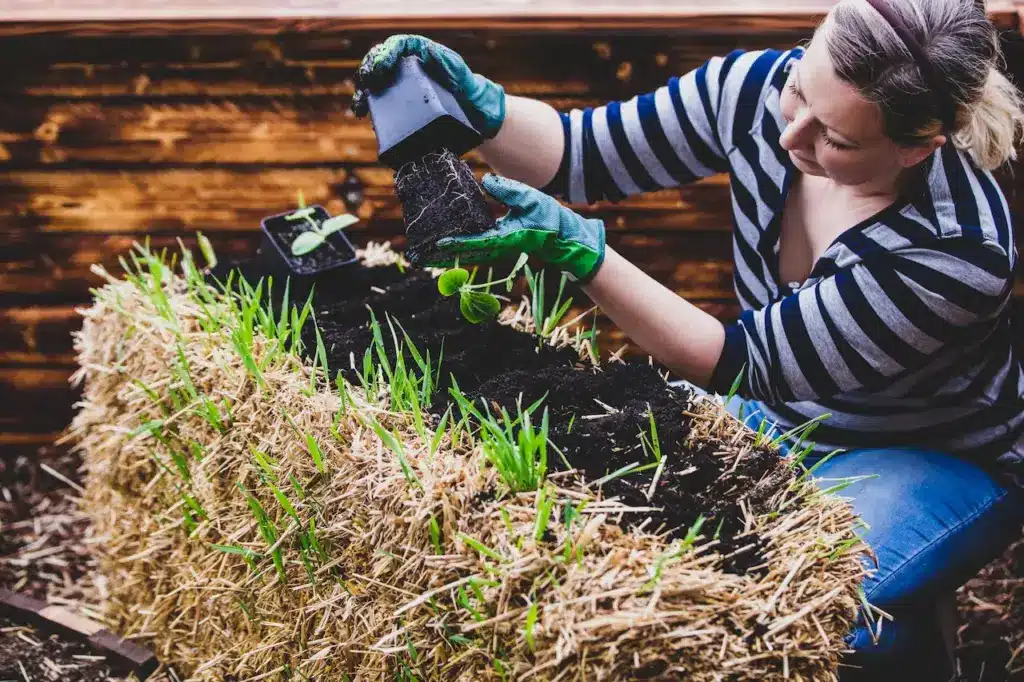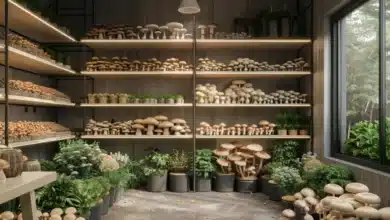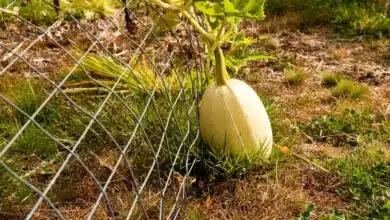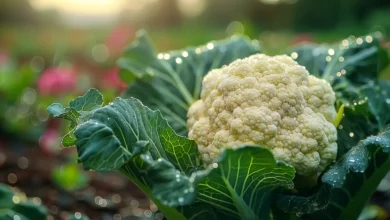Straw Bale Gardening: Affordable Food Growing
Straw Bale Gardening: Affordable Food Growing Solution For All
More people than ever feel drawn to gardening because of all the turmoil in our world these past few weeks. Growing your healthy food can be a source of confidence, but a garden is also able to provide reassurance during times of stress. This week’s episode is all about a simple way to start growing, using the straw bale method
Joel Karsten authored the book on growing in straw bales. Joel Karsten was a perfect example of the saying that necessity is the mother of invention. Joel grew up in southwest Minnesota on a farm and noticed as a youngster how thistles grew out of the broken bales near his family’s barn. Joel noticed that the bales decomposed into a rich, soil-like substance.
Joel eventually earned a degree from the University of Minnesota in horticulture. He was excited to plant a garden when he purchased his first house. The property was built over fill dirt. Joel had just bought the house and didn’t have any money left to construct raised beds or to start
His ingenuity kicked in, and his childhood memories came to the fore. He decided to establish a straw bale garden. Joel realized that he had hit the jackpot when his pepper and tomato plants flourished by the end of the first growing season.
Joel discovered over the years that almost everything thrives in a bale of straw – including root crops like potatoes and beets, vining plants such as cucumbers, and leafy greens. Sweet corn is the only exception, as it becomes too heavy to be supported by a straw bale. Other exceptions include rosemary and perennial roots such as asparagus or rhubarb.
The straw bale method is now popular in gardens around the world, nearly 30 years after Joel’s original experiments
Benefits and Common concerns
Straw bale gardening has many advantages, including being simple to set up. When it comes to access, the height of the bale can be a huge bonus. The bale is 18-22″ taller than a bed in the ground, which can be a big difference for some gardeners.
No garden tools? You don’t need to worry. You only need a pair of pruners and an planting trowel to grow a garden with straw bales.
You may have a few grain seeds that sprout between your plants but you will not have any weeds. What’s to dislike about that? Gardeners in cooler zones can plant earlier because of the heat generated by bacteria. The roots of warm-season plants can thrive in cool spring weather because they remain warm inside the bale. This means that crops can be harvested earlier.
Joel, on the other hand has discovered that roots inside a bale stay cooler in hot weather. The “swamp cooler effect” is created as moisture evaporates from the bale. Joel can harvest lettuce throughout the summer.
Gardening in bales doesn’t require much space, or even an area of earth. European gardeners have built straw bale gardens in their roofs. Gardeners around the world are building them on balconies and small patios. A community garden in New Jersey is constructed entirely of straw bales on a plot contaminated with toxic soil. The soil was covered with bales, which allows for food to be grown without soil contact.
A reduction in disease is another big benefit. The soilless bale is free of pathogens, and many diseases are soil-borne. Joel therefore recommends the use of sterile soilless mixture for small seedlings and covering exposed roots. Be aware that pathogens from disease can be transmitted to a bale. If you are dealing with a soil borne disease, avoid accidentally spreading the pathogens from your work gloves or garden trowel onto the plants in your bale gardens.
Joel is often asked by gardeners if the vegetables that are grown in bales taste as good as those grown in soil. He replies that the vegetables do taste good as long as they are decomposing and the bale has been properly conditioned. The bacteria in the bales can provide nutrients to the roots of plants, just as the soil foodweb in raised beds or in-ground gardens.
Joel has also experienced symptoms of magnesium deficiencies. These issues seem to be outweighed by his benefits.
Straw bale gardens are not a favorite of some gardeners. Although they are not the traditional garden, you can dress them up by adding flowers to the sides or decorative trellis.
Bale gardening can be a good way to provide food for families in the third world. Joel works with an organization that teaches local farmers how to bale rice straw instead of burning it off fields after harvest. The two are also sharing their seed-saving methods.
These families don’t have to spend any money on tools and supplies because they can use human urine to fertilize bales, and greywater from washing, cooking and bathing to irrigate. This type of innovative thinking is what keeps many people in need fed around the world.
Bales are prepared by conditioning
It is simple to grow straw bales, but you must first prepare the soil. As you begin planting, place the bale on its cut side. You can use the folded sides, but it is better to use the cut side (or prickly side) as this will allow water and nutrients to penetrate more easily.
The moisture and nutrients will encourage bacterial growth. For decomposition to occur in a compost pile bacterial activity and growth are required. Hay bales are no different. This is what creates the conditions that will support plant growth and produce.
Straw contains a high amount of carbon. Therefore, it is necessary to add nitrogen in order to create an environment conducive to bacterial growth. Joel suggests blood meal for the nitrogen. Pour the meal in the holes you make at the top of the bale. Add water next and watch the bacteria population explode.
Bacteria divide in half to multiply. A bacteria vibrates back and forth as it prepares to split. Each of the two bacteria is ready to split within 15 minutes. The vibrations create friction and friction produces heat. The interior temperature of a bale reaches up to 140 degrees Fahrenheit.
Heat is an indicator that your bales are conditioned well. Some of the material inside is decomposing and is ready to support plants. Joel will add more blood meal, or whatever nitrogen source is preferred to the bale every two days.
Joel suggests that you start the conditioning process at least 20 days prior to your last frost date. By Day 18, you should be able to seed the bale.
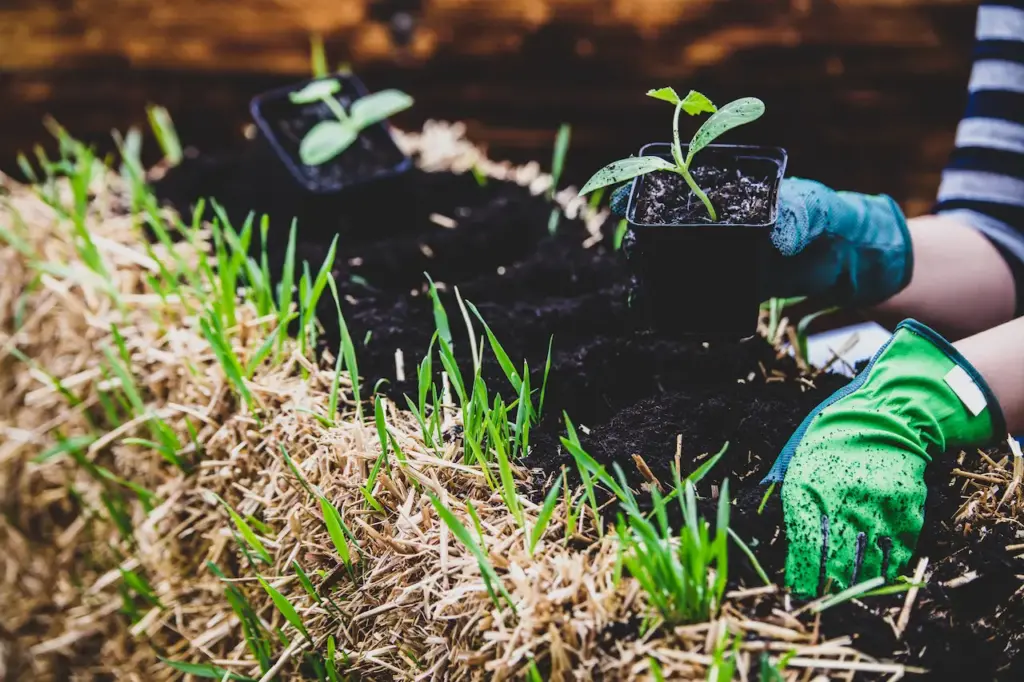
Sourcing Bales
Straw and hay are the most common bales. You may not know the differences if you haven’t grown up on a farming family.
Straw bales can be made using the stalks from cereal grains. The material is what’s left after the grain harvest. Straw bales, as a by-product, are cheaper. Because the grain stalks have hollow cores, they are also lighter. Straw takes a long time to decompose, so Joel’s bales tend to last two growing seasons.
Hay bales can be used to feed animals. Hay is more expensive because the grass crops, such as alfalfa or fescue are grown to be dried, baled, and used for food. Hay bales have a higher nitrogen content and are therefore heavier. They also break down more quickly. Joel found that most hay bales collapsed before the end of a growing season.
In most cases, seed from a hay harvest is present in the bale. This can result in grass sprouts growing in your garden. Farmers want to remove the grain from the stalks before baling them, so you are less likely to get unwanted sprouts.
Herbicides that persist in hay or straw bales are the biggest concern. Hay farmers spray herbicides on their fields to protect their crops. Grain farmers are not allowed to spray these chemicals. There is a risk of straw from either an overspray, or a grower who has a bad reputation.
It’s easy to test any bale and be confident that your plants will not suffer from it. The test is called a “bioassay”. Chop up a small amount of material, mix it with some potting soil, and then plant three small containers. Plant 3 small containers with just the potting mixture.
After a few weeks, the sprouts will be visible. You can see if they look healthy compared to the ones in potting soil. If the sprouts in the bale look stunted, you should avoid planting them.
Where can you buy bales? Joel suggests that you search for bales grown organically. The Department of Agriculture of each state has a listing of organic farmers, their crop(s), and contact information. If you can’t find any organic growers in your area, Craigslist or Facebook Marketplace are good options.
Many nurseries and garden centres carry bales of straw, and have usually checked the supplier for pesticides.
Proper Watering
Joel says that one of the biggest mistakes people make in gardening is to overwater . This also applies to straw bale gardening. The capacity of a bale is 3-5 gallons. Any water that exceeds this amount will drain.
Water draining from a straw bale contains some of the nitrogen that you have applied to support bacteria growth. Bales require no more than 1 gallon per bale, per day in the early part of the growing season to support plant growth. More than this can have a negative impact on the nutrients in the bale.
The bale will dry out faster as the season progresses. Joel suggests increasing the frequency of watering rather than watering at higher rates per dose, which could wash away nutrients.
The hose will break down quickly if it is exposed to sunlight. Joel recommends Drip irrigation. The irrigation tube has a longer lifespan and is easier to hide from the light. Plus, drip emitters allow for better control of the amount of water that is delivered to each plant type.
Set the timer to automatically deliver water. The system can deliver the water frequency that the straw bale gardens require, without washing away nutrients.
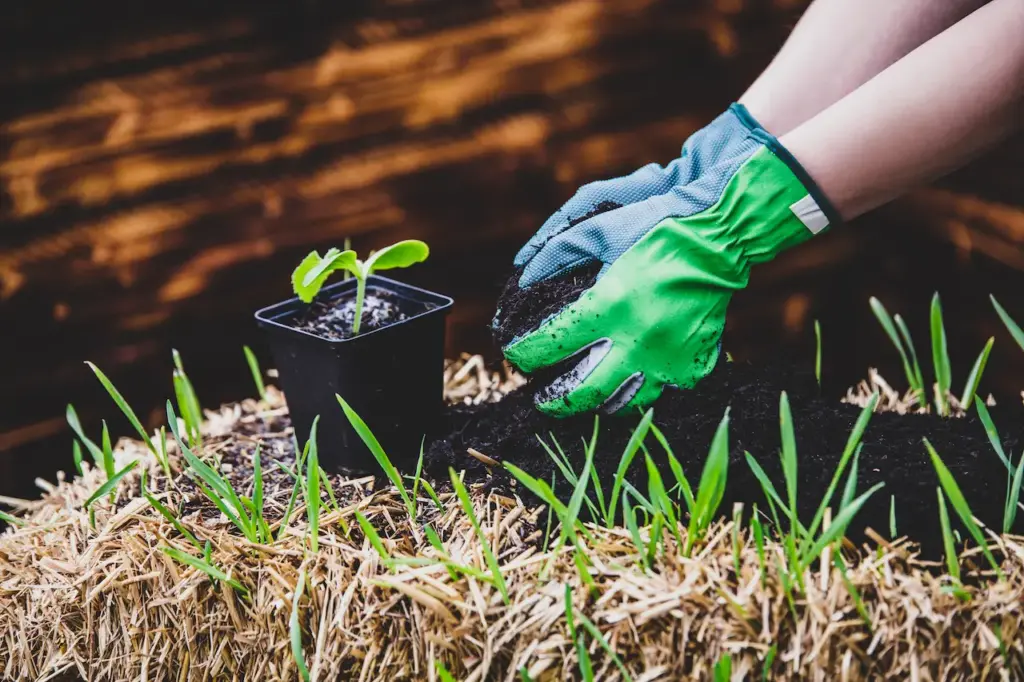
Planting Time
When it comes to planting in a conditioned bale, no soil is required – except for small seeds. If you want to grow crops like lettuce, carrots and radishes then it is best to cover the seeds lightly with soilless mix and lay a thin, sterile layer on top of the bale. Larger seeds like those of peas and beans or squash can be placed directly in the bale at a depth equal to the second knuckle of your finger.
Joel suggests planting in a checkerboard design to maximize the footprint of the bale.
Create a hole deep enough and wide enough for the roots and place the root ball into the cavity. Add a small amount of soilless mix if any roots are visible.
You can cover the bales with plastic and a trellis made of wire to create an almost tent-like structure. The cover will retain the heat created by the bacterial growth within the bale. Heat production can continue for up to eight weeks. This creates a comfortable climate for all crops, even those that are more delicate. You can keep the plastic from blowing in the wind by tucking it into the bale string.
Joel says that five bales of hay can produce enough crops in one season to feed a person. When deciding on what to plant, keep in mind the size of each plant. Indeterminate tomatoes, for instance, can take up a lot of space during the peak of the growing period. It’s better to limit them to just one per bale.
Be familiar with the mature plant size that is indicated on the seed packet.
Straw bales have a unique feature: you can insert small plants in the sides. In these spaces, herbs and flowers work well.
Joel plants crops strategically according to the age and size of the bale. A bale older than two years will decompose much faster than a brand new bale. This is the best environment for root crops. Joel will plant crops such as tomatoes, peppers, and eggplants in bales that have just been conditioned, and his root crops in bales from the second season.
Bales are usually too decomposed to grow another crop after the second year, but they make a wonderful potting material for container gardening. The decomposed material retains moisture just as well as the original bale, while still allowing for good drainage.

